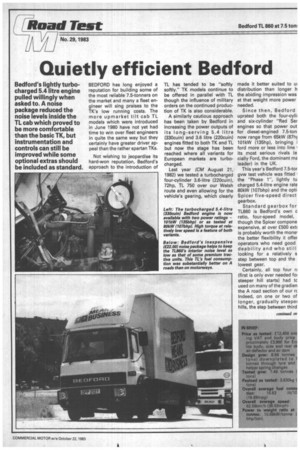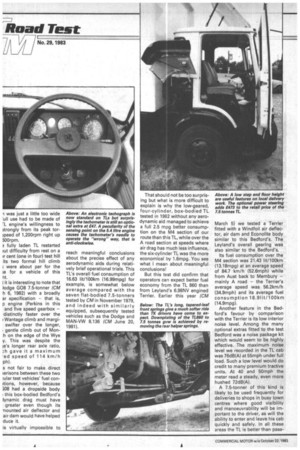Quietly efficient Bedford
Page 55

Page 56

Page 57

If you've noticed an error in this article please click here to report it so we can fix it.
Bedford's lightly turbocharged 5.4 litre engine pulled willingly when asked to. A noise package reduced the noise levels inside the TL cab which proved to be more comfortable than the basic TK, but instrumentation and controls can still be improved while some optional extras should be included as standard.
BEDFORD has long enjoyed a reputation for building some of the most reliable 7.5-tonners on the market and many a fleet engineer will sing praises to the TK's low running costs. The more upmarket tilt cab TL models which were introduced in June 1980 have not yet had time to win over fleet engineers in quite the same way but they certainly have greater driver appeal than the rather spartan TKs.
Not wishing to jeopardise its hard-won reputation, Bedford's approach to the introduction of
TL has tended to be "softly softly." TK models continue to be offered in parallel with TL though the influence of military orders on the continued production of TK is also considerable.
A similarly cautious approach has been taken by Bedford in increasing the power outputs of its long-serving 5.4 litre (330cuin) and 3.6 litre (220cuin) engines fitted to both TK and TL but now the stage has been reached where all variants for European markets are turbocharged.
Last year (CM August 21, 1982) we tested a turbocharged four-cylinder 3.6-litre (220cuin), 72hp, TL 750 over our Welsh route and even allowing for the vehicle's gearing, which clearly made it better suited to ui distribution than longer h the abiding impression was at that weight more power needed.
Since then, Bedford uprated both the four-cylii and six-cylinder "Red Ser engines so that power out for diesel-engined 7.5-ton now range from 65kW (87h1 101kW (135hp), bringing I ford more or less into line its most serious rivals (e dally Ford, the dominant me leader) in the UK.
This year's Bedford 7.5-tor gvw test vehicle was fitted the "Phase 1", lightly tu charged 5.4-litre engine rate 80kW (107bhp) and the opti, Spicer five-speed direct gearbox.
Standard gearbox for TL860 is Bedford's own c ratio, four-speed model, though the Spicer compone expensive, at over £500 exti is probably worth the mone, the better flexibility it offer operators who need good deability and who still looking for a relatively s step between top and the lowest gear.
Certainly, all top four n (first is only ever needed fol steeper hill starts) had tc used on many of the gradien the A road section of our rc Indeed, on one or two of longer, gradually steeper hills, the step between third
was just a little too wide 'ull use had to be made of -L engine's willingness to 3trongly from its peak tor;peed of 1,200rpm right up 300rpm.
3 fully laden TL restarted )ut difficulty from rest on a ir cent (one in four) test hill its two formal hill climb ; were about par for the ie for a vehicle of this nt.
I it is interesting to note that lodge G08 7.5-tonner (CM h 6, 1982) with a broadly ar specification — that is, p engine (Perkins in this and five speed gearbox — distinctly faster over the VVantage climb and margiswifter over the longer, gentle climb out of Montt on the edge of the Wye y. This was despite the le's longer rear axle ratio,
gave it a maximum • ed speed of 114 km/h ph).
s not fair to make direct ;orisons between these two n.ilar test vehicles' fuel conrtions, however, because 308 had a dropside body this box-bodied Bedford's iynamic drag must have greater even though its mounted air deflector and air dam would have helped duce it.
is virtually impossible to
reach meaningful conclusions about the precise effect of any aerodynamic aids during relatively brief operational trials. This TL's overall fuel consumption of 16.63 lit/100km (16.99mpg) for example, is somewhat below average compared with the seven flat-bodied 7.5-tanners tested by CM in November 1979, and indeed with similarly equipped, subsequently tested vehicles such as the Dodge and MAN-VW 8.136 (CM June 20, 1981). That should not be too surprising but what is more difficult to explain is why the low-geared, four-cylinder, box-bodied TL tested in 1982 without any aerodynamic aid managed to achieve a full 2.5 mpg better consumption on the M4 section of our route than this TL, while over the A road section at speeds where air drag has much less influence, the six-cylinder TL was the more economical by 1.6mpg. You see
what I mean about meaningful conclusions!
But this test did confirm that operators can expect better fuel economy from the TL 860 than from Leyland's 6.98NV engined Terrier. Earlier this year (CM
March 5) we tested a Terrier fitted with a Windfoil air deflector, air dam and Econolite body similar to this Bedford's, The Leyland's overall gearing was also similar to the Bedford's.
Its fuel consumption over the M4 section was 21.43 lit/100km (13.18mpg) at an average speed of 84.7 km/h (52.6mph) while from Aust back to Membury — mainly A road — the Terrier's average speed was 56.2km/h (34.9mph) and its average fuel consumption 18.91it/100km (14.9mpg).
Another feature in the Bedford's favour by comparison with the Terrier is its low interior noise level, Among the many optional extras fitted to the test Bedford was a noise package kit which would seem to be highly effective. The maximum noise level we recorded in the TL cab was 76dB(A) at 55mph under full load. Such a low level would do credit to many premium tractive units. At 40 and 50mph the meter read a steady, even more hushed 72c113(A).
A 7.5-tonner of this kind is likely to be used frequently for deliveries to shops in busy town centres where good visibility and manoeuvrability will be important to the driver, as will the ability to enter and leave his cab quickly and safely. In all these areas the TL is better than pass ably good without being exceptional, The TL 860's turning circle, for example, is slightly better than the Terrier's but not quite as good as either the GOB Dodge or MAN-VW 8.136, Our test vehicle was fitted with the optional Cam Gears power-assisted steering, which made light work of even the tightest turns, Though the TL's seating position is relatively high, access to the driver's seat is not difficult, owing to the low cab floor height and sturdy step tucked in neatly between the front bumper and front wing.
The deep windscreen and large rear-view mirrors (the same components as fitted to TM tractive units) combine to provide the driver with a good all-round field of vision, though this was spoiled slightly on our test vehicle by mirrors which vibrated badly when the engine was idling.
No local delivery driver will like the TL's heavy clutch pedal action which makes frequent gear changing in traffic a real chore. As the specification table shows, the maximum effort required to disengage the clutch was a hefty 36kg (791b). The absence of any face level fresh air vents in the TL cab was also a source of irritation on the two warm days over which we tested the vehicle.
Summary However, the overriding general impression that the TL left with me after two days behind its wheel was one of quiet if unspectacular efficiency. One thing is clear and that is that when purchasing a TL at 7.5 tonnes gvw an operator would do well to spend time studying the Bedford specification sheets in order to be sure he specifies the options that best suit his particular operation.
There is a very large number to choose from.
































































































